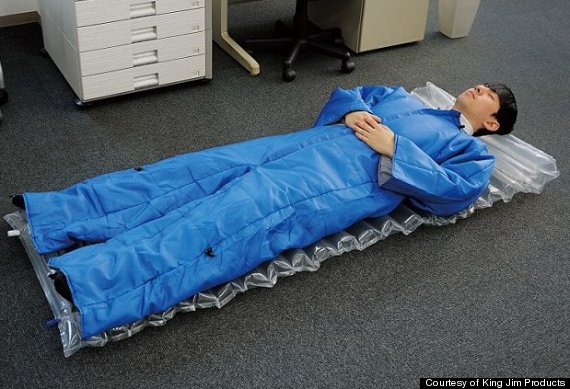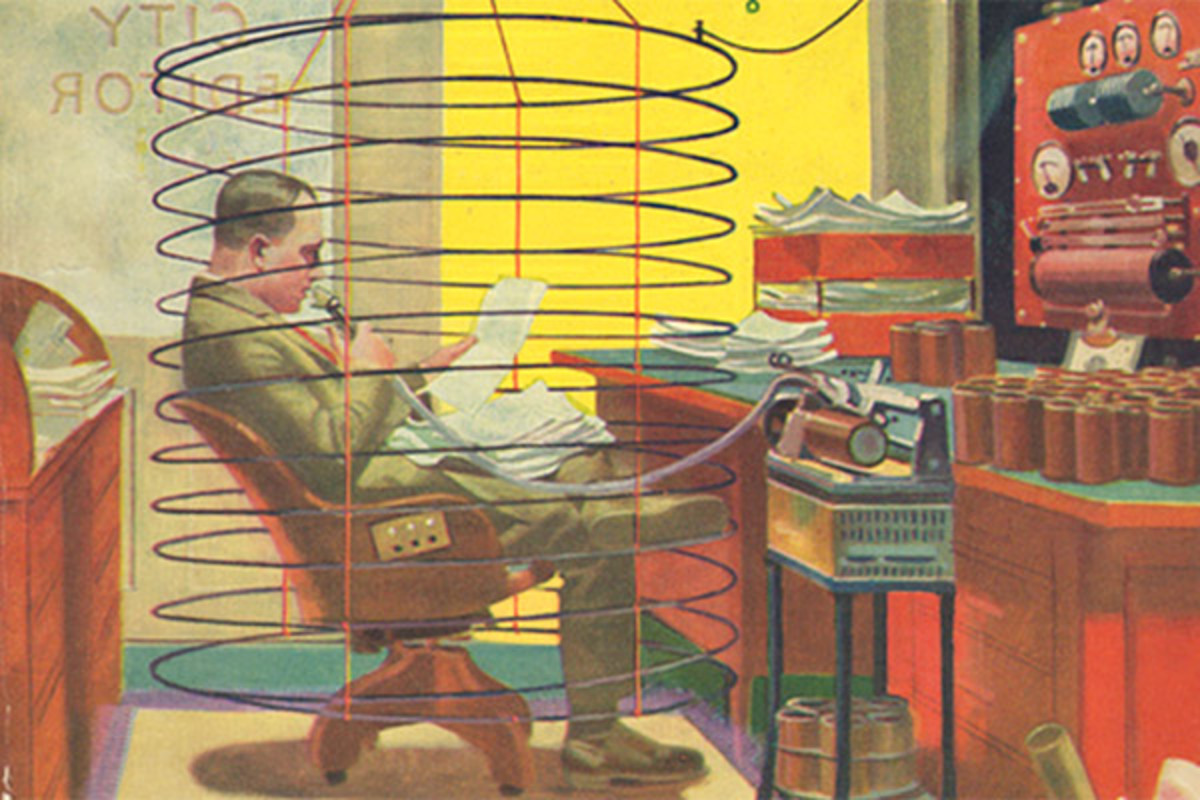We’re constantly on the lookout for ways to make ourselves more productive. From productivity hacks to lifestyle overhauls, we are obsessed with finding the key that will unlock our superhuman abilities to get things done faster. There’s a long history of inventions, ideas and innovations that are specifically designed to do just that.
Many of those ideas have evolved to become part of our everyday work lives. Others were useful at one point in time (carrier pigeons or the telegram) but have become obsolete in the face of new advancements. Then there are those that are just so strange that they leave us wondering why someone ever thought they’d be a good idea in the first place.
Here are 7 fascinating and outlandish inventions that people have created in the name of making us more productive that fell impressively wide of the mark.
The Electrical Sleep Eliminator
There’s no denying that electricity has completely revolutionized life as we know it. Unfortunately, as often happens with incredibly useful technology (radium health spas, anyone?), people have taken things too far.
Enter Hugo Jernsback, an inventor, publisher, and writer, who is also credited for helping establish science fiction as a genre. His idea (published in Science and Invention magazine in 1923) was that electrical currents could be passed through the air in an office. This would stimulate oxygen and ozone which would in turn stimulate the workers, getting them working at full efficiency again. To get rid of sluggishness (which he believed lurked in the cells of the nerves), he suggested that some mild shocks be applied to each worker through their chairs.
Jernsback theorized that this invention would totally eradicate the worker’s dependence on sleep. By his thinking, sleep was a useless evolutionary relic from when we were reliant on the sun for productivity. Sleep had no place in a world with artificial lighting, and electricity could easily shock people out of this inefficient habit.
Surprisingly, nobody ever decided to act on this revolutionary theory and sleep remains part of our everyday lives.
Key Takeaway: Any invention that is designed to reduce sleep, is not really a long-term productivity hack. It might be a temporary fix to help burn the midnight oil on occasion, but we categorically need sleep.
The Isolator
The Electrical Sleep Eliminator wasn’t Jernsback’s only contribution to the field of productivity. In 1925, he also introduced a design for The Isolator, intended to aid focus by removing all distractions.
The Isolator was a padded helmet that blocked out as much sound as possible. It also had glass-covered eyeholes which were almost entirely painted over, except for small lines to allow the wearer an incredibly limited field of vision. This was intended to stop the eyes from wandering away from the task at hand.
Jernsback created this invention for himself as he believed that distraction was the enemy of concentration. As he put it: “…the greatest difficulty that the human mind has to contend with is a lack of concentration, mainly due to outside influences. If by one stroke, we can do away with these influences, we will not only be benefitted greatly thereby but our work would be accomplished more quickly and the results would be vastly better.”
While The Isolator never ‘took off’, the theory behind it lives on even now. Sensory deprivation tanks for relaxation and using white noise to block out office distractions are both concepts that have gone mainstream in recent years. The celebrated novelist Jonathan Franzen has been known to write while wearing a blindfold and earplugs to achieve the same kind of effect that Jernsback was aiming for. So, while the isolator itself is a little nightmarish, the thought that went into it may not be so strange.
Key Takeaway: Aside from creative experimentation, there are no shortcuts to mastering concentration. It requires conscious examination of a productive environment, including the sensory experience. Blinders, at least of the physical sort, seem very unlikely to cut it.
Reading Machines
Before modern computing changed the game, jobs that involved a lot of reading had some sizeable limitations. Not only was someone’s productivity impacted by how fast they could read, they also had to deal with fetching and carrying bulky documents, the hassle of turning pages or the time-consuming task of locating a particular reference.
Fiske and His Reading Machine (Wikipedia)
The Fiske Reading Machine, created in the 1920s, was intended to solve many of these issues. It was a hand-held machine with a magnifying lens for one eye and a shield for the other. The reading material was printed in microscopic text on a card that could be inserted into the holder on the machine. All a user had to do was use the magnifier to focus on the bit of text that they wanted. Sizeable books and documents could be fit onto just a few cards.
While this idea wasn’t the success Fiske hoped for, eBooks and electronic reading aids have since become a huge part of our lives.
Key Takeaway: Was this a failure of UX? Scalability? Social acceptance? Sometimes productivity hacks are just way ahead of their time. But this one feels like it has a lot in common with VR (and it’s had slow adoption) – it’s an awkward technology, especially in public.
The Electric Pen
Quick-fire trivia time – can you name 5 famous inventors?
Chances are you included Bell, Tesla, and then a few others such as DaVinci, Archimedes, Ford, Franklin, and so forth. Thomas Edison likely also made your list.
While many of Edison’s creations have had a major impact on our lives, others are a little more obscure.
The electric pen was Edison’s attempt to solve an issue that was seriously impacting the productivity of offices throughout the US in the latter half of the 19th century. Was there an alternative way of making copies of documents that didn’t involve painstakingly copying them out by hand?
His idea (patented in 1876) was a needle powered by an electric motor that could be handled like a pen to write or draw. The movement of the ‘pen’ would create a stencil of minute puncture marks. It’s like a mini jackhammer. Documents could then be created by using the stencil and an ink roller on a sheet of paper.
The invention started out very well. However, there was a serious drawback in that the wet cell battery was messy and difficult for the average office worker to maintain. As less demanding stencil-making methods emerged and the typewriter began to grow in popularity, the Electric Pen soon fell by the wayside.
What makes the Electric Pen particularly interesting though is its legacy. Edison sold the design to Albert Dick who used the technology to create the mimeograph Machine, a much more successful way of duplicating documents. The pen is also credited as having brought a productivity revolution to a totally different industry by inspiring the electronic tattoo needle, something Edison probably didn’t foresee when he created it! So, while not exactly a failure, its fascinating construction and unusual second life earn it a place on this list.
Key Takeaway: When an idea has a serious enough flaw to render it unusable for the average user, it is not productive.
Microsoft’s Office Assistant
Few strange productivity inventions get and deserve the notoriety (or infamy) enjoyed by Microsoft’s Clippy. Intended to help people use Microsoft Office more efficiently, this little animated paperclip instead ended up infuriating millions and becoming prime fodder for memes years later.
In 1996, Microsoft released a range of animated assistants (with the default being a smiley paperclip, commonly nicknamed Clippy). They would bounce up on screen to offer advice on writing letters, saving files, correcting spelling mistakes and many other tasks.
People immediately started to become annoyed with the unsolicited advice. However, the program probably wouldn’t have become so universally panned if Microsoft had simply made it easy to turn off. Instead, the assistants were incredibly hard to dismiss, with many people having to alter the source code file name to banish them for good.
Today Clippy pops up as a meme, illustrating how not to provide help to your users. While this might be the only example on our list of the digital sort, it stands out as a simple idea that should’ve worked really well at improving our productivity but ended up falling flat.
Key Takeaway: Clippy is a tough one. It is making a bit of a comeback, perhaps mostly as a meme for something really annoying and intrusive. But perhaps the takeaway is don’t force a productivity hack down people’s throats. Productivity innovation should not only be inclusive and collaborative, but not invasive.
Amazon’s Ama-Zen Booths
Earlier this year, Amazon caused quite a stir with the announcement that they would be creating ‘Ama-zen Booths’ to give their stressed-out warehouse personnel a calm, safe space to retreat to for a few minutes of zen.
The ‘wellness chambers’ are small cubicle-like structures placed in the middle of the working area. A staff member climbs in and then chooses a mindfulness video to play. Lighting, fans, and plants are all intended to create a restful atmosphere while they watch.
Unfortunately, the reception this innovation received was anything but calming. The media was quick to point out that the pods resembled coffins and were like something out of a dystopic horror film. Amazon was also fiercely criticized for creating an unnecessary invention rather than trying to improve the working conditions that were causing stress in the first place.
People reasonably questioned when workers were actually meant to use the booths, given that many complain that they struggle to find time for bathroom breaks.
Key Takeaway: If your productivity fix is a bandaid on a very serious flaw, it’s not a productivity fix. It will only end in ridicule and will not improve productivity in the long term.
Wearable Futons
Another more recent idea that caught our attention is the wearable futon. This product, developed by Japanese Company Jim King, is meant to get you some rest wherever you may be. Sounds good, right? Nothing like a quick catnap on the go to improve your productivity.
It is exactly what it sounds like: a padded coat that unfolds into a makeshift bed. Take it off, team it with the included air mattress and drift off anywhere.
The product itself is ingenious, bizarre, or horrible, depending on who you ask. What was notable about the response though was the anxiety expressed by people worried about what it could mean for worker’s well-being. Japan already has a serious problem with sleep deprivation and people working a huge number of hours, so much so that companies have started introducing lunchtime naps.
This is an interesting tension wrapped up in the wearable tech movement. Some companies are investing in projects to make their workers more comfortable, like Audi who previously investigated wearable chairs for workers on their production line. At one level, this is great. But it also highlights a trend of further productizing human labor. Will making life easier for workers mean they are even more likely to work unhealthy amounts? And will companies expect them to put in longer and longer hours?
Key Takeaway: You could look at this kind of “productivity hack” as a simple gag or commentary on where we are as a society. But the signals it sends can’t be ignored.

Strange Inventions in the Name of Productivity: What’s Next?
We are unlikely to fall out of love with the idea that we can innovate our way to productivity. That’s especially the case as technology continues to evolve and change the productivity stakes. Whether that productivity is good or bad, or even self-defeating, is a matter for debate.
These odd ideas (luckily) failed or evolved into more useful tools. That said, with ideas like the wearable futon and Amazon’s wellness chambers – not to mention the insight they give into prevailing attitudes to the workplace – maybe the real question is whether we’ll still consider them strange 50 years from now.








